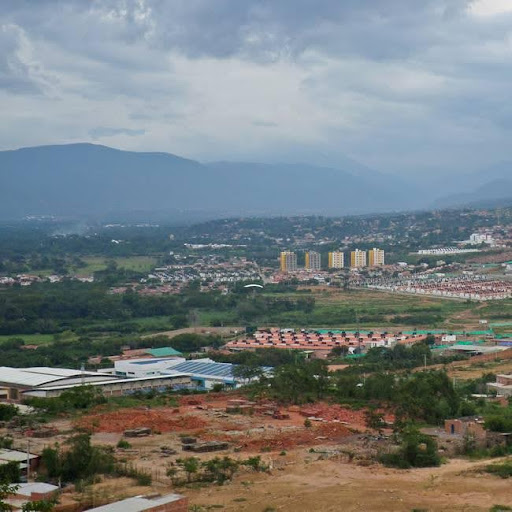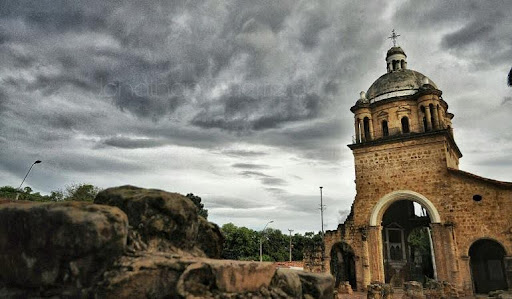VILLA DEL ROSARIO
Department

Flag of the Department of North Santander Department
Flag of the city
Its flag colours, yellow, red, and green represents its culture and values. It is in alignment with its motto “Noble, faithful, and courageous villa”


Slogan of the city
The slogan “Noble, Faithful, and Courageous Villa” succinctly encapsulates the values and identity of Villa del Rosario. Noble implies a sense of dignity, honor, and generosity. It suggests a community that upholds high moral principles and values. Faithful suggests loyalty, commitment, and reliability. It conveys a sense of unity and dedication among the residents of Villa del Rosario. Courage is synonymous with bravery and resilience. The term implies that the people of Villa del Rosario possess the strength to face challenges, whether historical, cultural, or contemporary, with determination and fearlessness. Combined, these characteristics form a powerful and positive image of the town, reflecting its historical significance, cultural heritage, and the admirable traits of its residents. The slogan serves not only as a description but as an aspirational statement, emphasizing the virtues that the community holds dear and strives to embody.
History

Villa del Rosario, with roots tracing back to its founder Don Asencio Rodriguez in 1750, has a compelling history marked by pivotal moments and notable figures. In the 1760s, the region, then known as “the Old Rosary,” witnessed the establishment of farms, laying the foundation for its early agricultural development. A significant turning point occurred on July 15, 1771, when prominent residents gathered with the intention of formalizing the creation of the parish. Seeking recognition, they petitioned Spanish monarch Carlos IV for the coveted title of Villa. This appeal resulted in the granting, on May 18, 1792, of the title “Noble, Leal y Valerosa Villa” (Noble, Loyal, and Valorous Villa) through a Royal Warrant. Villa del Rosario holds a unique place in Colombian history as the birthplace of General Francisco de Paula Santander, a key figure in the Revolution and the founding of the Republic. The town, referred to as the cradle of Colombia, saw the instruction of the gospel within its temple and the birth of the new homeland of Gran Colombia. The Congress of 1821, held in Villa del Rosario, played a crucial role in the creation of the Republic of Colombia.
The town contributed significantly to the cause of Colombian independence, producing heroes like Colonel Pedro Fortoul, Colonel José Concha, philosopher Frutos Joaquin Guitierrez de Caviedes, and priest Nicolas Mauricio de Omaña. These individuals, among many others, gave their lives for the freedom of Colombia. Beyond its historical contributions, Villa del Rosario has been the birthplace of noteworthy figures such as historian Luis Gabriel Castro and mathematician Manuel Antonio Rueda Jara. Both have left enduring legacies, with Castro known for his book “Traveling through the capital of Gran Colombia,” and Rueda Jara nationally recognized for his contributions to education and mathematical literature, including works like “The Toy of Numbers” and “Mercantile Accounting.” In essence, Villa del Rosario stands not only as a town with a rich history but as a place that has nurtured great minds and played a vital role in shaping the destiny of Colombia.
Geography of the city
Nestled within the embrace of a tropical savanna climate, Villa del Rosario experiences a marked dry season, defining its atmospheric conditions. According to the Köppen Climate Classification system, the city is characterized by an “Aw” climate, contributing to its distinct weather patterns. Positioned at coordinates 7°50′02″N latitude and 72°28′27″W longitude, Villa del Rosario finds itself situated amidst these geographical coordinates, marking its location within the broader landscape. The city’s elevation stands at 440 meters (1,440 feet) above sea level, influencing its topography and weather variations. Encompassing an area of 90.62 square kilometers (34.99 square miles), Villa del Rosario is a mosaic of urban and rural spaces. The urban area, covering 18.72 square kilometers (7.23 square miles), serves as the vibrant heart of the municipality.
In terms of population, the city was home to an estimated 111,254 residents as of 2020. The density of the municipality and city is calculated at 1,228 individuals per square kilometer (3,180 per square mile), portraying the dynamics of human habitation. Within the urban confines, where 107,991 people reside, the population density increases to 5,800 individuals per square kilometer (15,000 per square mile), reflecting the concentrated urban lifestyle. Zooming out to the broader perspective, the metropolitan area of Villa del Rosario extends its reach, enveloping an estimated 742,689 individuals. This broader demographic scope captures the interconnected lives and activities within and around Villa del Rosario, showcasing the city’s role as a focal point within its geographical context. These geographical and demographic facets not only paint a portrait of Villa del Rosario’s physical landscape but also provide a glimpse into the intricate interplay between climate, topography, and human settlement that defines the city’s character.

Population
Municipality and city – 111,254 (2020)
Urban – 107,991 (2020)
Metro – 742,689 (2020)
One photo representative of the city

Etymology
The term “Villa del Rosario” translates to “Village of the Rosary” in English. The name likely has religious connotations, referencing the Rosary, a form of prayer in the Catholic tradition that involves the repetition of prayers and the contemplation of specific events in the lives of Jesus Christ and the Virgin Mary. Many places in the Spanish-speaking world, particularly in Latin America, have names that reflect religious influences, historical events, or local traditions. In the case of Villa del Rosario, the name may be tied to the establishment of a religious site or the significance of the Rosary in the community’s cultural and spiritual life. The Rosary is a symbol of devotion in Catholicism, and the name suggests a connection to faith and religious practices in the area.
What the city is known or famous for

Notably, Villa del Rosario is the birthplace of General Francisco de Paula Santander, a key figure in the Revolution and the founding of the Republic. The city, referred to as the cradle of Colombia, witnessed the birth of Gran Colombia within its temple and hosted the Congress of 1821, which aimed to unite New Granada and Venezuela into the Republic of Colombia. Beyond its historical significance, Villa del Rosario is celebrated for its heroes of independence, including General Francisco de Paula Santander, Colonel Pedro Fortoul, Colonel José Concha, philosopher Frutos Joaquin Guitierrez de Caviedes, and priest Nicolas Mauricio de Omaña. These individuals, signatories of the act of independence in 1810, made immense sacrifices for Colombia’s freedom. The city’s contributions extend to notable figures like historian Luis Gabriel Castro and mathematician Manuel Antonio Rueda Jara. Castro’s work, “Traveling through the capital of Gran Colombia,” adds to the city’s intellectual legacy, while Rueda Jara is recognized nationally for his educational contributions and authored books such as “The Toy of Numbers” and “Mercantile Accounting.”
